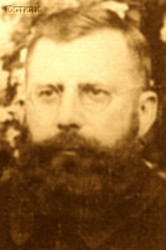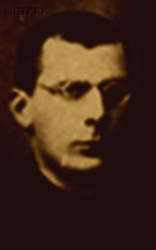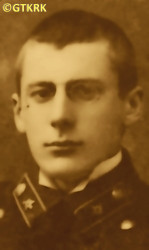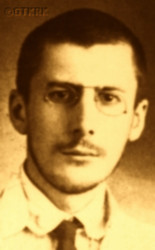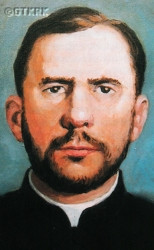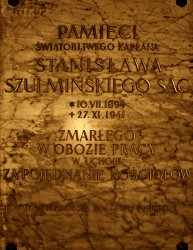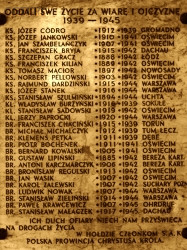Roman Catholic
St Sigismund parish
05-507 Słomczyn
85 Wiślana Str.
Konstancin deanery
Warsaw archdiocese, Poland
full list:
displayClick to display full list

searchClick to search full list by categories
wyświetlKliknij by wyświetlić pełną listę po polsku

szukajKliknij by przeszukać listę wg kategorii po polsku

Martyrology of the clergy — Poland
XX century (1914 – 1989)
personal data
religious status
Servant of God
surname
SZULMIŃSKI
forename(s)
Stanislav (pl. Stanisław)
function
religious cleric
creed
Latin (Roman Catholic) Church RCmore on
en.wikipedia.org
[access: 2014.09.21]
congregation
Society of the Catholic Apostolate SACmore on
en.wikipedia.org
[access: 2013.05.19]
(i.e. Pallottines)
diocese / province
Christ the King province SACmore on
waw.pallotyni.pl
[access: 2019.02.02]
Lutsk diocesemore on
en.wikipedia.org
[access: 2013.05.19]
Kamianets diocesemore on
en.wikipedia.org
[access: 2013.05.23]
academic distinctions
Bachelor of Sacred Theology
date and place
of death
27.11.1941

ITL UkhtIzhemLagGuLAG slave labour camp network
today: Ukhta, Izhemsky reg., Komi rep., Russia
details of death
After the German invasion of Poland on 01.09.1939 (the Russians attacked Poland 17 days later) and the start of World War II, went as planned to take up the position of rector in Okopy Święty Trójcy.
Reached Lutsk, and then Dubno in Volyn, where his family lived.
For unknown reasons, after the start of the Russian occupation, instead of going south, went north towards Lithuania (perhaps intended to get to Vilnius, occupied by Lithuanians) and reached Navahrudak.
There and on 24/26.10.1939 arrested by the Russians.
Jailed in the prison in Navahrudak, and then in Baranavichy.
Accused of „anti–Russian agitation and spying”.
Ten months later, on 21.08.1940, as the „socially dangerous entity” sentenced by a genocidal Special Council NKVD kangaroo court (known as «NKVD Troika») to 5 years of slave labour in Russian concentration camps Gulag.
On 21.03.1941 after 3 months long transport (started on 17.12.1940) brought to ITL UkhtIzhemLag concentration camp in Ukhta in Komi republic.
Among others slaved as a nurse in OLP 13 Kirpicznyj Zawod penal–isolation camp in Shudayag village (c. 200 km from Ukhta).
Secretly ministered to Catholics and other prisoners.
After German attack on 22.06.1941 of their erstwhile ally, the Russians, amnestied on 01.08.1941 — thanks to Sikorski–Mayski Polish–Russian accord.
Revealed himself as a priest, celebrated the Holy Mass to the prisoners being released, but voluntarily remained behind in the camp with those not released (according to other sources his release permission was withdrawn preventing him from joining Polish Army forming in Russia under Gen. Anders), tending to the prisoners and sufferers.
Perished soon after — found dead on his prison bunk (according to some sources — murdered).
cause of death
extermination
perpetrators
Russians
sites and events
ITL UkhtIzhemLagClick to display the description, UchtaClick to display the description, GulagClick to display the description, Baranavichy (prison)Click to display the description, Ribbentrop‐MolotovClick to display the description, Pius XI's encyclicalsClick to display the description
date and place
of birth
10.07.1894

Odessatoday: Odessa urban hrom., Odessa rai., Odessa obl., Ukraine
more on
en.wikipedia.org
[access: 2022.02.04]
parents
SZULMIŃSKI Alexander
🞲 1861, ? — 🕆 1944, Dubnotoday: Dubno urban hrom., Dubno rai., Rivne obl., Ukraine
more on
en.wikipedia.org
[access: 2020.11.27]

WYCHOWSKA Helen
🞲 ?, ? — 🕆 1919, ?
religious vows
15.08.1930 (temporary)
presbyter (holy orders)
ordination
08.07.1923

Buchachtoday: Buchach urban hrom., Chortkiv rai., Ternopil obl., Ukraine
more on
en.wikipedia.org
[access: 2020.11.15]
positions held
1939
rector — Fortetsya Svyatoyi Triytsitoday: Okopy, Melnytsia‐Podilska hrom., Chortkiv rai., Ternopil obl., Ukraine
more on
uk.wikipedia.org
[access: 2022.08.28] ⋄ Society's house, Pallottines SAC — appointee (then of a house near the border of Poland, Russia and Romania)
1936 – 1939
professor — Ołtarzewtoday: Ożarów Mazowiecki gm., Warsaw‐west pov., Masovia voiv., Poland
more on
en.wikipedia.org
[access: 2022.07.18] ⋄ Theological Seminary, Pallottines SAC — lecturer in moral, oriental and pastoral theology, pedagogy and homiletics, with responsibility for the catechetical and preaching practice of seminarians; also: father/spiritual director and confessor
30‐31.12.1937
founder — „Apostolate of Reconciliation” Association — association popularizing the idea of uniting Christians of Eastern and Western Churches, associating clergy and lay people from all over Poland
1932 – 1936
professor — Sucharytoday: Nakło nad Notecią gm., Nakło nad Notecią pov., Kuyavia‐Pomerania voiv., Poland
more on
en.wikipedia.org
[access: 2022.08.28] ⋄ Theological Seminary, Pallottines SAC — lecturer in moral, oriental and pastoral theology, pedagogy and homiletics, with responsibility for the catechetical and preaching practice of seminarians; also: father/spiritual director and confessor
1930 – 1932
spiritual father — Klecza Dolnatoday: Wadowice gm., Wadowice pov., Lesser Poland voiv., Poland
more on
en.wikipedia.org
[access: 2021.12.18] ⋄ „Collegium Marianum” Theological Seminary, „On the Mound” house, Pallottines SAC — also: catechist
1928 – 1930
novitiate — Ołtarzewtoday: Ożarów Mazowiecki gm., Warsaw‐west pov., Masovia voiv., Poland
more on
en.wikipedia.org
[access: 2022.07.18] ⋄ Society's house, Pallottines SAC — robed prob. on 15.08.1928
06.08.1928
accession — Ołtarzewtoday: Ożarów Mazowiecki gm., Warsaw‐west pov., Masovia voiv., Poland
more on
en.wikipedia.org
[access: 2022.07.18] ⋄ Society's house, Pallottines SAC
1927 – 1928
professor — Lutsktoday: Lutsk city rai., Volyn obl., Ukraine
more on
en.wikipedia.org
[access: 2021.09.17] ⋄ Theological Seminary — lecturer in i.a. Eastern theology
1923 – 1927
student — Lublintoday: Lublin city pov., Lublin voiv., Poland
more on
en.wikipedia.org
[access: 2021.08.20] ⋄ comparative theology, Catholic University of Lublin KUL [i.e. Catholic University of Lublin KUL (since 1928) / clandestine Catholic University of Lublin KUL (1939‐1944) / University of Lublin (1918‐1928)] — postgraduate specialised studies completed on 26.06.1928 with a bachelor's degree in Sacred Theology granted on the basis of submitted „The Problem of Providence in History” thesis
1919 – 1923
student — Tarnówtoday: Tarnów city pov., Lesser Poland voiv., Poland
more on
en.wikipedia.org
[access: 2021.06.07] ⋄ philosophy and theology, Theological Seminary
1917 – 1919
student — Zhytomyrtoday: Zhytomyr urban hrom., Zhytomyr rai., Zhytomyr obl., Ukraine
more on
en.wikipedia.org
[access: 2021.09.17] ⋄ philosophy and theology, Theological Seminary
sites and events
descriptions
ITL UkhtIzhemLag: Russian Rus. Исправи́тельно‐Трудово́й Ла́герь (Eng. Corrective Labor Camp) ITL Rus. Ухто‐Ижемский (Eng. Ukht‐Izhemskiy) — concentration and slave forced labor camp (within the Gulag complex) — headquartered in Ukhta (till 1939 known as Chibyu) in Izhma river region, in Komi Republic. Founded on 10.05.1938, after being carved out of the ITL UkhtPechLag concentration camp. Prisoners slaved at the exploration and extraction of crude oil, installation of drilling towers, construction of gas pipelines, oil processing plants, construction of tanks for crude oil and diesel oil, in building materials factories (e.g. bricks), quarries, logging and wood processing, in paper mills, construction and maintenance (clearing snow) of roads, in mechanical and repair workshops, during loading and unloading work, etc. Among them were many Poles brought in 1939 after the Russian invasion of Poland, Germans (i.e. of German extraction, including women, from the Volga region) and citizens of the Baltic countries (mainly after 1944). At its peak — till the death on 05.03.1953 of Russian socialist leader, Joseph Stalin — c. 40,000 prisoners were held there: e.g. 30,453 (01.07.1938); 27,006 (01.01.1939); 39,087 (01.07.1941); 25,331 (01.01.1942); 24,651 (01.01.1947); 34,072 (01.01.1948); 35,625 (01.01.1949); 37,180 (01.01.1950); 34,546 (01.01.1951); 33,544 (01.01.1952); 30,275 (01.01.1953). Ceased to operate on 18.05.1955 and was incorporated, together with many sub‐camps, into the ITL PechorLag concentration camp. (more on: old.memo.ruClick to attempt to display webpage
[access: 2024.04.08])
Uchta: Local capital of a series of Russian concentration camps and forced labour camps — among others in diamond mines and at oil production — part of GULAG penal system, in the Komi republic (beyond Arctic Circle) — such as Uchpechłag, ITL VorkutLag, Inta, Uchwymlag, ITL UkhtIzhemLag, Sieżeldor forced labour camps. (more on: pl.wikipedia.orgClick to attempt to display webpage
[access: 2013.08.17])
Gulag: The acronym Gulag comes from the Rus. Главное управление исправительно‐трудовых лагерей и колоний (Eng. Main Board of Correctional Labor Camps). The network of Russian concentration camps for slave labor was formally established by the decision of the highest Russian authorities on 27.06.1929. Control was taken over by the OGPU, the predecessor of the genocidal NKVD (from 1934) and the MGB (from 1946). Individual gulags (camps) were often established in remote, sparsely populated areas, where industrial or transport facilities important for the Russian state were built. They were modeled on the first „great construction of communism”, the White Sea‐Baltic Canal (1931‐1932), and Naftali Frenkel, of Jewish origin, is considered the creator of the system of using forced slave labor within the Gulag. He went down in history as the author of the principle „We have to squeeze everything out of the prisoner in the first three months — then nothing is there for us”. He was to be the creator, according to Alexander Solzhenitsyn, of the so‐called „Boiler system”, i.e. the dependence of food rations on working out a certain percentage of the norm. The term ZEK — prisoner — i.e. Rus. заключенный‐каналоармец (Eng. canal soldier) — was coined in the ITL BelBaltLag managed by him, and was adopted to mean a prisoner in Russian slave labor camps. Up to 12 mln prisoners were held in Gulag camps at one time, i.e. c. 5% of Russia's population. In his book „The Gulag Archipelago”, Solzhenitsyn estimated that c. 60 mln people were killed in the Gulag until 1956. Formally dissolved on 20.01.1960. (more on: en.wikipedia.orgClick to attempt to display webpage
[access: 2024.04.08])
Baranavichy (prison): Prison in 1939‐1941 run by Russians and in 1941‐1944 by Germans. (more on: pl.wikipedia.orgClick to attempt to display webpage
[access: 2013.08.17])
Ribbentrop‐Molotov: Genocidal Russian‐German alliance pact between Russian leader Joseph Stalin and German leader Adolf Hitler signed on 23.08.1939 in Moscow by respective foreign ministers, Mr. Vyacheslav Molotov for Russia and Joachim von Ribbentrop for Germany. The pact sanctioned and was the direct cause of joint Russian and German invasion of Poland and the outbreak of the World War II in 09.1939. In a political sense, the pact was an attempt to restore the status quo ante before 1914, with one exception, namely the „commercial” exchange of the so‐called „Kingdom of Poland”, which in 1914 was part of the Russian Empire, fore Eastern Galicia (today's western Ukraine), in 1914 belonging to the Austro‐Hungarian Empire. Galicia, including Lviv, was to be taken over by the Russians, the „Kingdom of Poland” — under the name of the General Governorate — Germany. The resultant „war was one of the greatest calamities and dramas of humanity in history, for two atheistic and anti‐Christian ideologies — national and international socialism — rejected God and His fifth Decalogue commandment: Thou shall not kill!” (Abp Stanislav Gądecki, 01.09.2019). The decisions taken — backed up by the betrayal of the formal allies of Poland, France and Germany, which on 12.09.1939, at a joint conference in Abbeville, decided not to provide aid to attacked Poland and not to take military action against Germany (a clear breach of treaty obligations with Poland) — were on 28.09.1939 slightly altered and made more precise when a treaty on „German‐Russian boundaries and friendship” was agreed by the same murderous signatories. One of its findings was establishment of spheres of influence in Central and Eastern Europe and in consequence IV partition of Poland. In one of its secret annexes agreed, that: „the Signatories will not tolerate on its respective territories any Polish propaganda that affects the territory of the other Side. On their respective territories they will suppress all such propaganda and inform each other of the measures taken to accomplish it”. The agreements resulted in a series of meeting between two genocidal organization representing both sides — German Gestapo and Russian NKVD when coordination of efforts to exterminate Polish intelligentsia and Polish leading classes (in Germany called «Intelligenzaktion», in Russia took the form of Katyń massacres) where discussed. Resulted in deaths of hundreds of thousands of Polish intelligentsia, including thousands of priests presented here, and tens of millions of ordinary people,. The results of this Russian‐German pact lasted till 1989 and are still in evidence even today. (more on: en.wikipedia.orgClick to attempt to display webpage
[access: 2015.09.30])
Pius XI's encyclicals: Facing the creation of two totalitarian systems in Europe, which seemed to compete with each other, though there were more similarities than contradictions between them, Pope Pius XI issued in 03.1937 (within 5 days) two encyclicals. In the „Mit brennender Sorge” (Eng. „With Burning Concern”) published on 14.03.1938, condemned the national socialism prevailing in Germany. The Pope wrote: „Whoever, following the old Germanic‐pre‐Christian beliefs, puts various impersonal fate in the place of a personal God, denies the wisdom of God and Providence […], whoever exalts earthly values: race or nation, or state, or state system, representatives of state power or other fundamental values of human society, […] and makes them the highest standard of all values, including religious ones, and idolizes them, this one […] is far from true faith in God and from a worldview corresponding to such faith”. On 19.03.1937, published „Divini Redemptoris” (Eng. „Divine Redeemer”), in which criticized Russian communism, dialectical materialism and the class struggle theory. The Pope wrote: „Communism deprives man of freedom, and therefore the spiritual basis of all life norms. It deprives the human person of all his dignity and any moral support with which he could resist the onslaught of blind passions […] This is the new gospel that Bolshevik and godless communism preaches as a message of salvation and redemption of humanity”… Pius XI demanded that the established human law be subjected to the natural law of God , recommended the implementation of the ideal of a Christian state and society, and called on Catholics to resist. Two years later, National Socialist Germany and Communist Russia came together and started World War II. (more on: www.vatican.vaClick to attempt to display webpage
[access: 2023.05.28], www.vatican.vaClick to attempt to display webpage
[access: 2023.05.28])
sources
personal:
wsdsac.plClick to attempt to display webpage
[access: 2012.12.28], libermortuorum.plClick to attempt to display webpage
[access: 2017.11.16], gulagmuseum.orgClick to attempt to display webpage
[access: 2019.05.30], ru.openlist.wikiClick to attempt to display webpage
[access: 2019.10.13], pl.catholicmartyrs.orgClick to attempt to display webpage
[access: 2013.01.06], www.katolicy.euClick to attempt to display webpage
[access: 2021.12.19], www.pallotyni.plClick to attempt to display webpage
[access: 2013.05.19]
bibliographical:
„Register of Latin rite Lviv metropolis clergy’s losses in 1939‐45”, Józef Krętosz, Maria Pawłowiczowa, editors, Opole, 2005
„Biographical lexicon of Lviv Roman Catholic Metropoly clergy victims of the II World War 1939‐1945”, Mary Pawłowiczowa (ed.), Fr Joseph Krętosz (ed.), Holy Cross Publishing, Opole, 2007
original images:
pl.catholicmartyrs.orgClick to attempt to display webpage
[access: 2013.07.06], pl.catholicmartyrs.orgClick to attempt to display webpage
[access: 2013.07.06], libermortuorum.plClick to attempt to display webpage
[access: 2017.11.16], szulminski.plClick to attempt to display webpage
[access: 2023.12.01], libermortuorum.plClick to attempt to display webpage
[access: 2017.11.16], libermortuorum.plClick to attempt to display webpage
[access: 2017.11.16], turystyka.ozarow-mazowiecki.plClick to attempt to display webpage
[access: 2017.11.07], ipn.gov.plClick to attempt to display webpage
[access: 2019.02.02]
LETTER to CUSTODIAN/ADMINISTRATOR
If you have an Email client on your communicator/computer — such as Mozilla Thunderbird, Windows Mail or Microsoft Outlook, described at WikipediaPatrz:
en.wikipedia.org, among others — try the link below, please:
LETTER to CUSTODIAN/ADMINISTRATORClick and try to call your own Email client
If however you do not run such a client or the above link is not active please send an email to the Custodian/Administrator using your account — in your customary email/correspondence engine — at the following address:

giving the following as the subject:
MARTYROLOGY: SZULMIŃSKI Stanislav
To return to the biography press below:
 Click to return to biography
Click to return to biography








